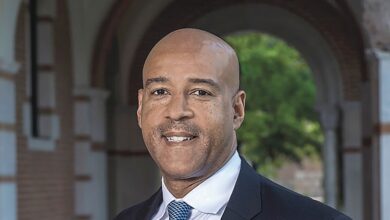A Hybrid-Work Semester Is Wrapping Up. Here Are Some Emerging Best Practices.

[ad_1]
The hot experiment on college campuses this fall has had more to do with who’s in cubicles than what’s in pipettes. Universities across the country have tried out a hybrid work force, charting a path that’s neither fully on Zoom nor wholly dependent on people sitting at their desks.
The hypothesis is that several days of at-home work, mixed with a few days at the office, may raise morale and mitigate turnover, even though it might be challenging to adopt. The results are still coming in — but best practices are emerging.
Paul J. Hutchinson, a senior lecturer in Boston University’s Questrom School of Business, teaches about organizational behavior and team development. This semester, he has been speaking informally with departments on his campus about the evolving nature of the academic workplace. He’s also given advice to his colleagues: This month he held a staff workshop about hybrid teams. Here are five takeaways from what he has learned:
1. Everything comes back to trust. Trust is the coin of the realm in interpersonal relations, Hutchinson said. How do you build it? By being vulnerable.
“Far too often as a leader, we are expected to have the answers and we want to present ourselves as if we have the answers,” he said. “We’re in the midst of a historic global crisis. We don’t have the answers. Nobody has the answers. And there’s a humility and a vulnerability, but an authenticity, in saying, ‘I don’t know.’”
A common mistake occurs when employees are asked for feedback but leaders “just snap back to what they were going to do anyways,” he said. “That’s a great way to undermine trust. Folks know their opinions are not really valued. The manager has to take a risk … Let’s try this for three months. See how it goes. And then we’ll have another meeting and talk about what’s working.”
2. Three key aspects of trust: accountability, social relationships, and power. In Hutchinson’s recent workshop, he stressed those three dynamics as they relate to building trust between higher-education employees and their managers.
When jobs are being done in person, managers often try to gauge productivity by whether employees are at their desks. A different approach, suitable for hybrid work, is to talk about expectations and how to meet them. “If your job this week is to get these two grants done, who cares whether you do it in 40 hours or 30 hours or 60 hours? It’s what’s called a results-only work environment,” Hutchinson said. “That idea of, Let’s really look at what the job is and focus on that. And then who cares if you’re in the office?”

Courtesy of Paul Hutchinson
As for the subject of social relationships, Hutchinson recommends that teams identify which interactions add value because they are in person and which do not and so can remain online. Having team members commute to the office for one meeting erodes productivity. One possible strategy, he said, is to have purposeful, shared on-campus days for teams — with the goal of those days to bolster social bonds. “As a manager, how do you make the most of that Tuesday?” he asked. “How do you make those days be really socially productive, really networking productive?”
The third area is internal power and influence. People must fight their instincts to “grasp” power and instead to empower others. “When people have freedom, motivation comes from it,” Hutchinson said. “Commitment comes from it.”
For employees, hybrid work requires an awareness of their influence on their own team. “If you want to work for that promotion, if you want to get put on that new project, you want to be on the forefront of your boss’s mind,” Hutchinson said. “People need to be very intentional about how do they show up at work, when do they show up at work, and in what ways do they present themselves so that their supervisor can really recognize them and see the impact that they’re making?”
3. Managers need to be open to change. Hutchinson has advice for those who lead college offices. First, ask what kind of accountability you need from hybrid staff members to feel as if you can trust your team. Then, ask what system can achieve that — without your staff’s feeling micromanaged.
Prioritize open conversations over one-size-fits-all strategies. Managers should feel as if they can comfortably ask what their employees need, and vice versa. “We both know we want to get the job done,” he said. “We’re not out to undermine each other. Then we’re going to develop that level of trust between each other while we’re figuring out what’s going to work.”
Be prepared to change tactics as a semester continues. And recognize that flexibility and autonomy can be assets in retaining employees. “Think about the amount of chronic stress that folks are facing,” Hutchinson said. Choice in where one works can improve mental health, which can affect a team’s performance.
4. Maximize the use of time on campus — and off. Hutchinson has years of firsthand experience. He lives in New Hampshire and, even before the pandemic, worked in a hybrid manner. Back then, on his on-campus days, he networked and met in person “almost every hour of the day,” he said. But in his two to three days working from home, he graded papers and reviewed budgets — “the work you can’t get done because you’re always in meetings,” he said. “That stuff was getting done on those remote days, when I was also not losing time in traffic.”
If a team leader is hesitant about allowing hybrid work, employees should lean on communication and explain what they’re doing when they’re out of the office, Hutchinson recommended. One tactic, he said, is to use an online calendar to map out the day’s work. “Look for ways to demonstrate that accountability,” he said.
5. Don’t just try to snap back to “normal.” Why do so many campus leaders seem so eager to do that? Because all this is complicated! “We want to go back to the way we know it used to work because there was good stuff in that,” Hutchinson said. “It’s an easier move than to this halfway, blended, who’s back, who’s not back.”
But that is unwise, Hutchinson said. The last 21 months have taught colleges that asynchronous online meetings can work. Defaulting to in-person arrangements for everything may not always be best.
[ad_2]
Source link






